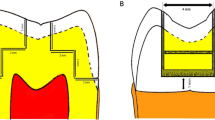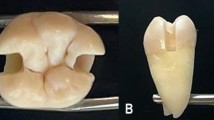Abstract
The purpose of this study was to investigate the marginal adaptation and microleakage of SonicFill composite with different photopolymerization techniques. Class II cavities were prepared in 40 premolars and divided into groups according to the photopolymerization technique (n = 10): G1:1200 mW/cm2 for 20 s; G2:1200 mW/cm2 for 40 s; G3:Soft-start with 650 mW/cm2 for 5 s and 1200 mW/cm2 for 15 s; G4:Soft-start with 650 mW/cm2 for 10 s and 1200 mW/cm2 for 30 s. The cavities were restored with OptiBond FL adhesive and SonicFill. Epoxy resin replicas were obtained before and after thermocycling. The occlusal and cervical margins were analyzed with scanning electron microcopy and expressed as the percentage of continuous margins (%CM). The specimens were submitted to microleakage with silver nitrate. ANOVA and Tukey’s test revealed that the %CM at the linguo-occlusal margin for group 1 (83.19%) was significantly different from groups 2, 3 and 4, which had values over 95%. At the cervical margin, there was no statistically significant difference between the groups. After thermocycling, there was a significant decrease in %CM. The predominant score of microleakage was 1 in enamel and 3 in dentin. The SonicFill composite led to gap formation and microleakage, especially in the dentin at the cervical margin, regardless of the photopolymerization technique employed.




Similar content being viewed by others
References
Walter R. Critical appraisal: bulk-fill flowable composite resins. J Esthet Restor Dent. 2013;25:72–6.
Garcia D, Yaman P, Dennison J, Neiva G. Polymerization shrinkage and depth of cure of bulk fill flowable composite resins. Oper Dent. 2014;39:441–8.
Al Sunbulh H, Silikas N, Watts DC. Polymerization shrinkage kinetics and shrinkage-stress in dental resin-composite. Dent Mater. 2016;32:998–1006.
Bucutas S, Ilie N. Light transmittance and micro-mechanical properties of bulk fill vs. conventional resin based composites. Clin Oral Investig. 2014;18:1991–2000.
Alrahlah A, Silikas N, Watts DC. Post-cure depth of cure of bulk fill dental resin-composites. Dent Mater. 2014;30:149–54.
Garoushi S, Säilynoja E, Vallittu PK, Lassila L. Physical properties and depth of cure of a new short fiber reinforced composite. Dent Mater. 2013;29:835–41.
Goracci C, Cadenaro M, Fontanive L, Giangrosso G, Juloski J, Vichi A, Ferrari M. Polymerization efficiency and flexural strength of low-stress restorative composites. Dent Mater. 2014;30:688–94.
Tarle Z, Attin T, Marovic D, Andermatt L, Ristic M, Tauböck TT. Influence of irradiation time on subsurface degree of conversion and microhardness of high-viscosity bulk-fill resin composites. Clin Oral Investig. 2014;19:831–40.
Benetti AR, Havndrup-Pedersen C, Honoré D, Pedersen MK, Pallesen U. Bulk-fill resin composites: polymerization contraction, depth of cure, and gap formation. Oper Dent. 2015;40:190–200.
Ilie N, Stark K. Curing behaviour of high-viscosity bulk-fill composites. J Dent. 2014;42:977–85.
Ilie N, Bucuta S, Draenert M. Bulk-fill resin-based composites: an in vitro assessment of their mechanical performance. Oper Dent. 2013;38:618–25.
Geerts S, Bolette A, Seidel L, Guéders A. An in vitro evaluation of leakage of two etch and rinse and two self-etch adhesives after thermocycling. Int J Dent. 2012;12:1–7.
Gregor L, Bortolotto T, Feilzer AJ, Krejci I. Shrinkage kenetics of a methacrylate- and a silorane-based resin composite: effect on marginal integrity. J Adhes Dent. 2013;15:245–50.
Braga RR, Hilton TJ, Ferracane JL. Contraction stress of flowable composite materials and their efficacy as stress-relieving layers. J Am Dent Assoc. 2003;134:721–8.
Van Meerbeek B, De Munck J, Yoshida Y, Inoue S, Vargas M, Vijay P, Van Landuyt K, Lambrechts P, Vanherle G. Buonocore memorial lecture. Adhesion to enamel and dentin: current status and future challenges. Oper Dent. 2003; 28:215–35.
Sarr M, Kane AW, Vreven J, Mine A, Van Landuyt KL, Peumans M, Lambrechts P, Van Meerbeek B, De Munck J. Microtensile bond strength and interfacial characterization of 11 contemporary adhesives bonded to bur-cut dentin. Oper Dent. 2010;35:94–104.
de Paula EA, Tay LY, Kose C, Mena-Serrano A, Reis A, Perdigão J, Loguercio AD. Randomized clinical trial of four adhesion strategies in cervical lesions: 12-month results. Int J Esthet Dent. 2015;10:122–45.
Ilie N, Hickel R. Resin composite restorative materials. Aust Dent J. 2011;56:59–66.
Rueggeberg F. Contemporary issues in photocuring. Compend Contin Educ Dent Suppl. 1999;25:S4–15.
Kwon TY, Bagheri R, Kim YK, Kim KH, Burrow MF. Cure mechanisms in materials for use in esthetic dentistry. J Investig Clin Dent. 2012;3:3–16.
Vandewalle KS, Ferracane JL, Hilton TJ, Erickson RL, Sakaguchi RL. Effect of energy density on properties and marginal integrity of posterior resin composite restorations. Dent Mater. 2004;20:96–106.
Lim BS, Ferracane JL, Sakaguchi RL, Condon JR. Reduction of polymerization contraction stress for dental composites by two-step light-activation. Dent Mater. 2002;18:436–44.
Charton C, Colon P, Pla F. Shrinkage stress in light-cured composite resins: influence of material and photoactivation mode. Dent Mater. 2007;23:911–20.
Oliveira KM, Lancellotti AC, Ccahuana-Vásquez RA, Consani S. Shrinkage stress and degree of conversion of a dental composite submitted to different photoactivation protocols. Acta Odontol Latinoam. 2012; 25:115–22.
Asmussen E, Peutzfeldt A. Polymerization contraction of resin composite vs. energy and power density of light-cure. Eur J Oral Sci. 2005;113:417–21.
Campos EA, Ardu S, Lefever D, Jassé FF, Bortolotto T, Krejci I. Marginal adaptation of class II cavities restored with bulk-fill composites. J Dent. 2014;42:575–81.
Tay FR, Hashimoto M, Pashley DH, Peters MC, Lai SC, Yiu CK, Cheong C. Aging affects two modes of nanoleakage expression in bonded dentin. J Dent Res. 2003;82:537–41.
Bennett AW, Watts DC. Performance of two blue light-emitting-diode dental light curing units with distance and irradiation-time. Dent Mater. 2004;20:72–9.
Krämer N, Reinelt C, Frankenberger R. Ten-year clinical performance of posterior resin composite restorations. J Adhes Dent. 2015;17:433–41.
Kalmowicz J, Phebus JG, Owens BM, Johnson WW, King GT. Microleakage of class I and II composite resin restorations using a sonic-resin placement system. Oper Dent. 2015;40:653–61.
Sakaguchi RL, Douglas WH, Peters MC. Curing light performance and polymerization of composite restorative materials. J Dent. 1992;20:183–8.
Doerr CL, Hilton TJ, Hermesch CB. Effect of thermocycling on the microleakage of conventional and resin-modified glass ionomers. Am J Dent. 1996;9:19–21.
Yap AU. Effects of storage, thermal and load cycling on a new reinforced glass-ionomer cement. J Oral Rehabil. 1998;25:40–4.
Gale MS, Darvell BW. Thermal cycling procedures for laboratory testing of dental restorations. J Dent. 1999;27:89–99.
Amaral FLB, Colucci V, Palma-Dibb RG, Corona SAM. Assessment of in vitro methods used to promote adhesive interface degradation: a critical review. J Esthet Restor Dent. 2007;19:340–53.
Aggarwal V, Logani A, Jain V, Shah N. Effect of cyclic loading on marginal adaptation and bond strength in direct vs. indirect class II MO composite restorations. Oper Dent. 2008;33:587–92.
Juloski J, Goracci C, Rengo C, Giovannetti A, Vichi A, Vulicevic ZR, Ferrri M. Enamel and dentin bond strength of new simplified adhesive materials with and without preliminary phosphoric acid-etching. Am J Dent. 2012;25:239–43.
Catelan A, De Araújo LS, Da Silveira BC, Kawano Y, Ambrosano GM, Marchi GM, Aguiar FH. Impact of the distance of light curing on the degree of conversion and microhardness of a composite resin. Acta Odontol Scand. 2015;73:298–301.
Hasanreĭsoğlu U, Sönmez H, Uçtaşli S, Wilson HJ. Microleakage of direct and indirect inlay/onlay systems. J Oral Rehabil. 1996;23:66–71.
Gerdolle DA, Mortier E, Loos-Ayav C, Jacquot B, Panighi MM. In vitro evaluation of microleakage of indirect composite inlays cemented with four luting agents. J Prosthet Dent. 2005;93:563–70.
Manhart J, Schmidt M, Chen HY, Kunzelmann KH, Hickel R. Marginal quality of tooth-colored restorations in class II cavities after artificial aging. Oper Dent. 2001;26:357–66.
Hannig M, Reinhardt KJ, Bott B. Self-etching primer vs phosphoric acid: an alternative concept for composite-to-enamel bonding. Oper Dent. 1999;24:172–80.
Pashley DH, Tay FR. Aggressiveness of contemporary self-etching adhesives. Part II: etching effects on unground enamel. Dent Mater. 2001;17:430–44.
Al-Harbi F, Kaisarly D, Michna A, ArRejaie A, Bader D, El Gezawi M. Cervical interfacial bonding effectiveness of class II bulk versus incremental fill resin composite restorations. Oper Dent. 2015;40:622–35.
Nedeljkovic I, Teughels W, De Munck J, Van Meerbeek B, Van Landuyt KL. Is secondary caries with composites a material-based problem? Dent Mater. 2015;31:e247–77.
Agarwal RS, Hiremath H, Agarwal J, Garg A. Evaluation of cervical marginal and internal adaptation using newer bulk fill composites: an in vitro study. J Conserv Dent. 2015;18:56–61.
Heintze SD, Monreal D, Peschke A. Marginal quality of class II composite restorations placed in bulk compared to an incremental technique: evaluation with SEM and stereomicroscope. J Adhes Dent. 2015;17:147–54.
de Assis FS, Lima SN, Tonetto MR, Bhandi SH, Pinto SC, Malaquias P, Loguercio AD, Bandéca MC. Evaluation of bond strength, marginal integrity, and fracture strength of bulk- vs incrementally-filled restorations. J Adhes Dent. 2016;18:317–23.
Van Dijken JW, Pallesen U. A randomized controlled three year evaluation of “bulk-filled” posterior resin restorations based on stress decreasing resin technology. Dent Mater. 2014;30:245–51.
Van Dijken JW, Pallesen U. Posterior bulk-filled resin composite restorations: a 5-year randomized controlled clinical study. J Dent. 2016;51:29–35.
Bayraktar Y, Ercan E, Hamidi MM, Colak H. One-year clinical evaluation of different types of bulk-fill composites. J Investig Clin Dent. 2016;22:1–9.
Acknowledgements
The authors thank the Central Laboratory of Microscopy and Microanalysis of PUCRS for the images of Scanning Electron Microscopy. The present study was carried out with the support of the Program Students-Agreement of Post-Graduation—PEC-PG, CAPES/CNPq, Brazil.
Author information
Authors and Affiliations
Corresponding author
Ethics declarations
Conflict of interest
The authors declare that they have no conflict of interest.
Rights and permissions
About this article
Cite this article
Gamarra, V.S.S., Borges, G.A., Júnior, L.H.B. et al. Marginal adaptation and microleakage of a bulk-fill composite resin photopolymerized with different techniques. Odontology 106, 56–63 (2018). https://doi.org/10.1007/s10266-017-0294-5
Received:
Accepted:
Published:
Issue Date:
DOI: https://doi.org/10.1007/s10266-017-0294-5




